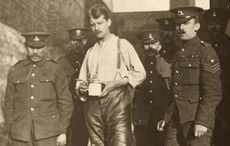There have been many times in my life when a situation develops where I fear I am going to fail. Whenever the odds against me seem insurmountable or I cannot think of a solution, I remind myself of an individual who faced complete ruin after achieving tremendous success in a variety of business endeavors: railroad equipment and supply salesman, racing stable owner, railway car manufacturer, steel mill owner, farmer, stock speculator, philanthropist, and all around bon vivant and gourmand. Incredibly, this person did not plan to become any of these. Chance, happenstance, and equal portions of hard work and self motivation were his tools of success.
His name was James Buchanan Brady, though he was better known by his nom de plume “Diamond Jim” for his propensity of wearing enough diamonds in public so as to glitter like a French chandelier.
Jim was born on August 12, 1856 above the saloon his father owned in the west side of Manhattan. He literally grew up around his father’s bar, observing how political deals and business arrangements were made. Then, in 1863, his father died suddenly. Though his mother quickly remarried, Jim did not get along with his new stepfather, who turned the bar into a dive and shanghai center. So at the age of eleven, Jim and his older brother Dan left home. Jim soon found employment at the elegant St. James Hotel as a bellboy. For the next few years he had a ringside seat in observing how the “other half” of society lived – industrialists, bankers, robber barons and kings of commerce all dressed to the nines, and always accompanied by equally fashionable ladies in the latest haute couture.
Always a bright and congenial person, Jim, by the age of 15, was given his first real career opportunity by one of the hotel’s regular patrons, John M. Toucey, an executive with the New York Central Railroad. Mr. Toucey made the following proposition: if Jim was willing to take a cut in pay to start in the baggage department and go to business college at night to study bookkeeping, he would be given an opportunity to advance himself. Jim readily accepted.
By the time he was 21, Jim was made chief clerk and confidential right-hand man to Mr. Toucey, under whose tutelage Jim learned the inner secrets of the railroad business: organization, cost analysis, reliability performances of locomotive equipment, repair scheduling and just about anything related to efficient office administration.
Then Jim was fired
A few years earlier, Jim had managed to have his brother hired by the New York Central. Unfortunately, Dan was later caught raiding the petty-cash box. The accepted mores of the day dictated that Jim be discharged too. This was something John Toucey, now the General Manager, was reluctant to do. He genuinely liked Jim and he was also afraid that a rival railroad would hire him and thus be privy to New York Central’s corporate secrets – at the time the New York Legislature was about to begin a major investigation into railroad practices.
Toucey arranged an interview for his young assistant with his friend Charles Moore, a partner with Manning, Maxwell & Moore, a major railroad supply company. Even though Jim had no sales experience and his rough-hewn speech often included “dems” and “does,” Moore was won over by Jim’s genial nature and natural charm. That, and his extensive knowledge of railroad operations. He was hired immediately.
Before going on the road, Jim made certain that he was properly outfitted. Recalling his days at the St. James, he knew that in order to make money you have to look like money, so he spent his savings on several hand-tailored suits, a stove pipe hat, a fur-collared overcoat, and a one carat diamond ring (which successful men of the day wore as a display of their credit rating and not as a frivolous adornment). When making a sales call it was not uncommon for Jim to be mistaken as a member of the board of directors and not some common “drummer.”
In no time “Diamond Jim” became the number one salesman in the country. He accomplished this by engaging in the sort of intelligence gathering normally associated with a secret agent. Before stepping into the purchasing superintendent’s office, Jim would spend days, even weeks, reconnoitering the railroad’s network right down to the tool shacks and the gandy dancers who kept the track straight. In other words, he got to know the men who really ran the railroads: section foremen, mechanics, stationmasters and conductors and he acquired all sorts of inside information as to equipment and repair shop needs and current and future requirements. Jim would often know the needs of the railroad better than the executives and this was the reason for his success. He soon became wealthy enough to support his mother in a new house, now that his stepfather had abandoned her and headed west.
After a few years, fate intervened again
In 1888, Sampson Fox of the Leeds Forge Company of England tried, and failed, to sell American railroad companies his all-steel Fox Undertruck. This was a lightweight undercarriage made of pressed steel from a formula his company developed and was in use in Britain. At the time, American railroad undercarriages were made of wood and the railroad magnates saw no reason to change. Fox’s last stop was to Charles Moore who declined the offer to become the company’s U.S. representative. However, Moore told Fox that he had a top salesman on his payroll and that if he wanted to sell his undertruck as a sideline, that was all right with him. Over dinner that night, Fox made his offer: If Jim would represent Fox in the U.S., they would provide him with the technical expertise to produce the undertruck and pay him a 33 1/2 percent commission on every one he sold. With an incentive like that, Jim decided to convert every undercarriage used in America over to the Fox Undertruck.
Jim found a blacksmith shop in Joliet, Illinois and immediately had them fabricate ten undercarriages for the newly formed Fox Pressed Steel company. He knew from experience that American railroad men were the most conservative, if not the most hardheaded, of businessmen. Talking about your product meant nothing to them. They had to see for themselves in order to be convinced.
Brady began his campaign at the offices of the New York Central, then the leading railroad in the country. He made an appointment with the motive-power superintendent and boldly declared that if they didn’t at least give him the opportunity of a demonstration he would give the Pennsylvania Railroad, New York Central’s chief rival, the chance to be first on the list for a product that would provide an edge on shipping costs. This was because the all-steel undercarriage was stronger than the wooden version – and thus could carry more, lasted longer, and required less “off line” time for maintenance and repair. If anyone else made this statement they most likely would have been thrown out the door, but “Diamond Jim” wasn’t just anyone. His reputation as America’s top salesman preceded him and he was granted his test run, providing he supplied twenty railcars. It meant working overtime to produce the extra ten undercarriages, but they were delivered on time.
For the test itself, the cars were filled halfway with scrap metal and rock. Jim, on seeing this, ordered the cars to be filled to the top, “to make it a real test.” The run was from Albany to New York City and back, a route full of turns and twists. The test was a success, making the trip in good time. The New York Central placed an order for one hundred steel undercarriages.
Jim then went to the Pennsylvania Railroad and quickly sold them the next lot. Not to be outdone by their main rival, they ordered two hundred and fifty undercarriages. Within a few months both railroads announced that they were going to convert all of their rolling stock to the Fox Undercarriage. With that sort of endorsement, every railroad in the country sent in orders. By early 1889, Jim was selling hundreds of undercarriages a week at his now greatly expanded facility. He also included in his shops the manufacture of hydraulic brakes, fireboxes, and an assortment of other railroad equipment.
Jim was now living the good life. His home was a large mansion on Eighty-Sixth Street, he enjoyed dining and entertaining on a baronial scale at New York’s finest restaurants; wore diamonds on his buttons, watch, belt buckle, scarf pin, eyeglass case, rings, tie pins, walking cane and cuff links; and was the constant companion of Lillian Russell, the voluptuous leading star of the American stage (and who preferred his company over that of J. P. Morgan). Jim also became the owner in a racing stable and even bought a farm in New Jersey, the bounty of which often ended up in gift baskets to his numerous friends in the railroad industry and in the theater.
Then disaster struck
Pittsburgh empire builder Andrew Carnegie noticed the tremendous profits the Brady operation was generating and began to raise prices on the steel they were buying from him. His plan was to either force Brady to sell out to him, or force him into bankruptcy and then pick up the pieces of his operation at bargain prices. Brady chose neither option. He would fight.
The key to winning was to find another dependable source of steel. Not an easy task with Carnegie’s tentacles reaching into every steel mill in the country.
Brady had discovered that the Carbon Steel Company of Pittsburgh was being pushed into bankruptcy by Carnegie. He had to act fast. Time did not allow for him to trawl Wall Street in search of venture capitalists, but recalling his days at his father’s bar, he began to make the rounds at the better watering holes around Manhattan until he found a couple of Wall Street investors who were tempted by the idea of becoming men of steel. Brady made them the following proposition: if they would purchase Carbon Steel and make Brady a partner in the new firm, he would provide them with the process for creating high tensile steel and Fox Pressed Steel would buy all the steel they could produce.
The new company was a greater success than Brady could have imagined, and no doubt caused Carnegie to seethe in rage. The canny Scotsman had been outmaneuvered by an Irish American! The demand for pressed steel was so great that a second factory was soon built, and in time, Carbon Steel Company began producing steel for many of the larger locomotive companies.
Jim was now living an even better life. The poor boy from lower Manhattan was now earning about one million dollars a year in commissions (and remember, this was in the days when the dollar was gold backed and there was no income tax) from the Carbon Steel Company, Fox Pressed Steel and from Manning, Maxwell & Moore. Incredibly, Jim insisted on continuing working for his original employer, stating that Charles Moore had given him his start as a salesman and had introduced him to Sampson Fox. As wealthy as “Diamond Jim” became, he never forgot how important it is to be loyal to others.
Jim, who succumbed to a heart attack and died in his sleep at the age of 61, bequeathed a collection of 30 diamond-encrusted watches (one of which was formerly owned by Napoleon) to his tailor and best friend Jules Weiss. He left $10,000 each to the New York Central Employees’ Hospital, the Newsboys’ Lodging Home, the Roman Catholic Orphan Asylum, the Children’s Aid Society, and the Actors’ Fund of America. Even his favorite Pullman porter received $2,500. Jim had earlier torn up about $250,000 in I.O.U.’s provided for his brother and sister and given about $1,500,000 in jewelry to various women.
The remainder of Jim’s fortune was divided between New York Hospital and Johns Hopkins in Baltimore, Maryland, home to the James Buchanan Brady Urological Institute, which is rated as the best urological institute in the country.
Jim is buried with his parents in Holy Cross Cemetery, Brooklyn, New York.




Comments